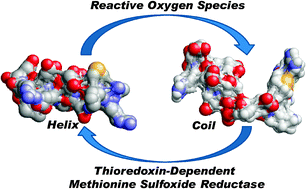Thioredoxin-dependent redox regulation of cellular signaling and stress response through reversible oxidation of methionines
Abstract
The sensitive oxidations of sulfur containing

a
Cell Biology & Biochemistry Group, Biology Division, Fundamental and Computational Sciences Directorate, Pacific Northwest National Laboratory, P.O. Box 999, MS P7-56, Richland, Washington, USA
E-mail:
thomas.squier@pnl.gov, diana.bigelow@pnl.gov
Fax: +1 509-371-7304
Tel: +1 509-371-6925
The sensitive oxidations of sulfur containing

 Please wait while we load your content...
Something went wrong. Try again?
Please wait while we load your content...
Something went wrong. Try again?
D. J. Bigelow and T. C. Squier, Mol. BioSyst., 2011, 7, 2101 DOI: 10.1039/C1MB05081H
To request permission to reproduce material from this article, please go to the Copyright Clearance Center request page.
If you are an author contributing to an RSC publication, you do not need to request permission provided correct acknowledgement is given.
If you are the author of this article, you do not need to request permission to reproduce figures and diagrams provided correct acknowledgement is given. If you want to reproduce the whole article in a third-party publication (excluding your thesis/dissertation for which permission is not required) please go to the Copyright Clearance Center request page.
Read more about how to correctly acknowledge RSC content.
 Fetching data from CrossRef.
Fetching data from CrossRef.
This may take some time to load.
Loading related content
